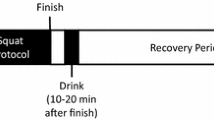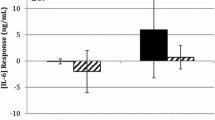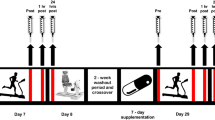Abstract
Purpose
To investigate the effect of acute alcohol consumption on muscular performance recovery, assessed by maximal torque production, and on inflammatory capacity, assessed by lipopolysaccharide (LPS)-stimulated cytokine production, following muscle-damaging resistance exercise in women.
Methods
Thirteen recreationally resistance-trained women completed two identical exercise bouts (300 maximal single-leg eccentric leg extensions) followed by alcohol (1.09 g ethanol kg−1 fat-free body mass) or placebo ingestion. Blood was collected before (PRE), and 5 (5 h-POST), 24 (24 h-POST), and 48 (48 h-POST) hours after exercise and analyzed for LPS-stimulated cytokine production (TNF-α, IL-1β, IL-6, and IL-8 and IL-10). Maximal torque production (concentric, eccentric, isometric) was measured for each leg at PRE, 24 h-POST, and 48 h-POST.
Results
Although the exercise bout increased LPS-stimulated production of TNF-α (%change from PRE: 5 h-POST 109%; 24 h-POST 49%; 48 h-POST 40%) and decreased LPS-stimulated production of IL-8 (5 h-POST −40%; 24 h-POST −50%; 48 h-POST: −43%) and IL-10 (5 h-POST: −37%; 24 h-POST −32%; 48 h-POST −31%), consuming alcohol after exercise did not affect this response. Regardless of drink condition, concentric, eccentric, and isometric torque produced by the exercised leg were lower at 24 h-POST (concentric 106 ± 6 Nm, eccentric 144 ± 9 Nm, isometric 128 ± 8 Nm; M ± SE) compared to PRE (concentric 127 ± 7 Nm, eccentric 175 ± 11 Nm, isometric 148 ± 8 Nm). Eccentric torque production was partially recovered and isometric torque production was fully recovered by 48 h-POST.
Conclusions
Alcohol consumed after muscle-damaging resistance exercise does not appear to affect inflammatory capacity or muscular performance recovery in resistance-trained women. Combined with previous findings in men, these results suggest a gender difference regarding effects of alcohol on exercise recovery.



Similar content being viewed by others
Abbreviations
- 5 h-POST:
-
Five hours after exercise time point
- 24 h-POST:
-
Twenty-four hours after exercise time point
- 48 h-POST:
-
Forty-eight hours after exercise time point
- ALC:
-
Alcohol condition
- ANOVA:
-
Analysis of variance
- BAC:
-
Blood alcohol concentration
- CK:
-
Creatine kinase
- IL:
-
Interleukin
- LPS:
-
Lipopolysaccharide
- NF:
-
Nuclear regulatory factor
- PLA:
-
Placebo condition
- PRE:
-
Pre-exercise time point
- TNF:
-
Tumor necrosis factor
- VAS:
-
Visual analog scale
References
Afshar M, Richards S, Mann D, Cross A, Smith GB, Netzer G, Kovacs E, Hasday J (2015) Acute immunomodulatory effects of binge alcohol ingestion. Alcohol 49(1):57–64
Amelink GJ, Bar PR (1986) Exercise-induced muscle protein leakage in the rat. Effects of hormonal manipulation. J Neurol Sci 76(1):61–68
Arbabi S, Garcia I, Bauer GJ, Maier RV (1999) Alcohol (ethanol) inhibits IL-8 and TNF: role of the p38 pathway. J Immunol 162(12):7441–7445
Arnold L, Henry A, Poron F, Baba-Amer Y, van Rooijen N, Plonquet A, Gherardi RK, Chazaud B (2007) Inflammatory monocytes recruited after skeletal muscle injury switch into antiinflammatory macrophages to support myogenesis. J Exp Med 204(5):1057–1069
Babor, TF, Higgins-Biddle, JC, Saunders, JB, Monteiro, MG (2001) The alcohol use disorders identification test: Guidelines for use in primary care. World Health Organization (WHO Publication No. 01.6a)
Baeuerle PA, Henkel T (1994) Function and activation of NF-κB in the immune system. Annu Rev Immunol 12:141–179
Baird DT, Fraser IS (1974) Blood production and ovarian secretion rates of estradiol-17β and estrone in women throughout the menstrual cycle. J Clin Endocrinol Metab 38(6):1009–1017
Bar PR, Amelink GJ, Oldenburg B, Blankenstein MA (1988) Prevention of exercise-induced muscle membrane damage by oestradiol. Life Sci 42(26):2677–2681
Barnes MJ, Mündel T, Stannard SR (2010a) Post-exercise alcohol ingestion exacerbates eccentric-exercise induced losses in performance. Eur J Appl Physiol 108(5):1009–1014
Barnes MJ, Mündel T, Stannard SR (2010b) Acute alcohol consumption aggravates the decline in muscle performance following strenuous eccentric exercise. J Sci Med Sport 13(1):189–193
Barry AE, Piazza-Gardner AK (2012) Drunkorexia: understanding the co-occurrence of alcohol consumption and eating/exercise weight management behaviors. J Am Coll Health 60(3):236–243
Cannon JG, St Pierre BA (1998) Cytokines in exertion-induced skeletal muscle injury. Mol Cell Biochem 179(1–2):159–167
Cannon JG, Meydani SN, Fielding RA, Fiatarone MA, Meydani M, Farhangmehr M, Orencole SF, Blumberg JB, Evans WJ (1991) Acute phase response in exercise. II. Associations between vitamin E, cytokines, and muscle proteolysis. Am J Physiol 260(6):R1235–R1240
Carpenter KC, Breslin WL, Adams A, McFarlin BK (2013) Baker’s yeast β-glucan supplementation increases monocytes and cytokines post-exercise: implications for infection risk? Br J Nutr 109:478–486
Clarkson PM, Reichsman F (1990) The effect of ethanol on exercise-induced muscle damage. J Stud Alcohol 51(1):19–23
Damsgaard CT, Lauritzen L, Calder PC, Kjaer TM, Frokiaer H (2009) Whole-blood culture is a valid low-cost method to measure monocytic cytokines—a comparison of cytokine production in cultures of human whole-blood, mononuclear cells and monocytes. J Immunol Methods 340(2):95–101
Duplanty AA, Budnar RG, Luk HY, Levitt DE, Hill DW, McFarlin BK, Huggett DB, Vingren JL (2017) Effect of acute alcohol ingestion on resistance exercise induced mTORC1 signaling in human muscle. J Strength Cond Res 31:54–61
Ford JA (2007) Alcohol use among college students: a comparison of athletes and nonathletes. Subst Use Misuse 42(9):1367–1377
Goral J, Kovacs EJ (2005) In vivo ethanol exposure down-regulates TLR2-, TLR4-, and TLR9-mediated macrophage inflammatory response by limiting p38 and ERK1/2 activation. J Immunol 174(1):456–463
Goral J, Choudhry MA, Kovacs EJ (2004) Acute ethanol exposure inhibits macrophage IL-6 production: role of p38 and ERK1/2 MAPK. J Leukoc Biol 75(3):553–559
Haugvad A, Haugvad L, Hamarsland H, Paulsen G (2014) Ethanol does not delay muscle recovery but decreases testosterone/cortisol ratio. Med Sci Sports Exerc 46(11):2175–2183
Hurlbut SC, Sher KJ (1992) Assessing alcohol problems in college students. J Am Coll Health 41(2):49–58
LaStayo PC, Woolf JM, Lewek MD, Snyder-Mackler L, Reich T, Linsdtedt SL (2003) Eccentric muscle contractions: their contributions to injury, prevention, rehabilitation, and sport. J Orthop Sports Phys Ther 33(10):557–571
Levitt DE, Duplanty AA, Budnar RG Jr, Luk H, Fernandez A, Layman TJ, Fancher DL, Hill DW, McFarlin BK, Vingren JL (2016) The effect of post-resistance exercise alcohol ingestion on lipopolysaccharide-stimulated cytokines. Eur J Appl Physiol 116(2):311–318
Mandrekar P, Catalano D, Szabo G (1997) Alcohol-induced regulation of nuclear regulatory factor-κβ in human monocytes. Alcohol Clin Exp Res 21(6):988–994
Mandrekar P, Catalano D, White B, Szabo G (2006) Moderate alcohol intake in humans attenuates monocyte inflammatory responses: inhibition of nuclear regulatory factor kappa B and induction of interleukin 10. Alcohol Clin Exp Res 30(1):135–139
Markofski MM, Braun WA (2014) Influence of menstrual cycle on indices of contraction-induced muscle damage. J Strength Cond Res 28(9):2649–2656
Martens MP, Dams-O’Connor K, Beck NC (2006) A systematic review of college student-athlete drinking: prevalence rates, sport-related factors, and interventions. J Subst Abuse Treat 31(3):305–316
McFarlin BK, Flynn MG, Campbell WW, Stewart LK, Timmerman KL (2004) TLR4 is lower in resistance-trained older women and related to inflammatory cytokines. Med Sci Sports Exerc 36(11):1876–1883
McLeay Y, Stannard SR, Mundel T, Foskett A, Barnes M (2016) Effect of alcohol consumption on recovery from eccentric exercise induced muscle damage in females. Int J Sport Nutr Exerc Metab 13:30
Moore MJ, Werch C (2008) Relationship between vigorous exercise frequency and substance use among first-year drinking college students. J Am Coll Health 56:686–690
Nelson TF, Wechsler H (2001) Alcohol and college athletes. Med Sci Sports Exerc 33(1):43–47
Nosaka K, Newton M (2002) Repeated eccentric exercise bouts do not exacerbate muscle damage and repair. J Strength Cond Res 16(1):117–122
Serrano AL, Baeza-Raja B, Perdiguero E, Jardi M, Munoz-Canoves P (2008) Interleukin-6 is an essential regulator of satellite cell-mediated skeletal muscle hypertrophy. Cell Metab 7(1):33–44
Sizemore N, Leung S, Stark GR (1999) Activation of phosphatidylinositol 3-kinase in response to interleukin-1 leads to phosphorylation and activation of the NF-kappaB p65/RelA subunit. Mol Cell Biol 19(7):4798–4805
Stupka N, Lowther S, Chorneyko K, Bourgeois JM, Hogben C, Tarnopolsky MA (2000) Gender differences in muscle inflammation after eccentric exercise. J Appl Physiol 89(6):2325–2332
Szabo G, Mandrekar P, Girouard L, Catalano D (1996) Regulation of human monocyte functions by acute ethanol treatment: decreased tumor necrosis factor-alpha, interleukin-1 beta and elevated interleukin-10, and transforming growth factor-beta production. Alcohol Clin Exp Res 20(5):900–907
Szabo G, Chavan S, Mandrekar P, Catalano D (1999) Acute alcohol consumption attenuates interleukin-8 (IL-8) and monocyte chemoattractant peptide-1 (MCP-1) induction in response to ex vivo stimulation. J Clin Immunol 19(1):67–76
Tiidus PM, Holden D, Bombardier E, Zajchowski S, Enns D, Belcastro A (2001) Estrogen effect on post-exercise skeletal muscle neutrophil infiltration and calpain activity. Can J Physiol Pharmacol 79(5):400–406
Verma BK, Fogarasi M, Szabo G (1993) Down-regulation of tumor necrosis factor α activity by acute ethanol treatment in human peripheral blood monocytes. J Clin Immunol 13(1):8–22
Vingren J, Hill D, Buddhadev H, Duplanty A (2013) Postresistance exercise ethanol ingestion and acute testosterone bioavailability. Med Sci Sports Exerc 45(9):1825–1832
Yaqoob P, Newsholme EA, Calder PC (1999) Comparison of cytokine production in cultures of whole human blood and purified mononuclear cells. Cytokine 11(8):600–605
Acknowledgements
This study was funded in part by a grant from the National Strength and Conditioning Association Foundation.
Author information
Authors and Affiliations
Corresponding author
Ethics declarations
Conflict of interest
The authors declare that they have no conflicts of interest.
Ethical approval
All procedures performed in this study involving human participants were in accordance with the ethical standards of, and approved by, the Institutional Review Board of the University of North Texas and in accordance with the 1964 Helsinki declaration and its later amendments. This article does not contain any studies with animals performed by the authors.
Informed consent
Informed consent was obtained from all individual participants included in the study.
Additional information
Communicated by William J. Kraemer.
Rights and permissions
About this article
Cite this article
Levitt, D.E., Luk, HY., Duplanty, A.A. et al. Effect of alcohol after muscle-damaging resistance exercise on muscular performance recovery and inflammatory capacity in women. Eur J Appl Physiol 117, 1195–1206 (2017). https://doi.org/10.1007/s00421-017-3606-0
Received:
Accepted:
Published:
Issue Date:
DOI: https://doi.org/10.1007/s00421-017-3606-0




